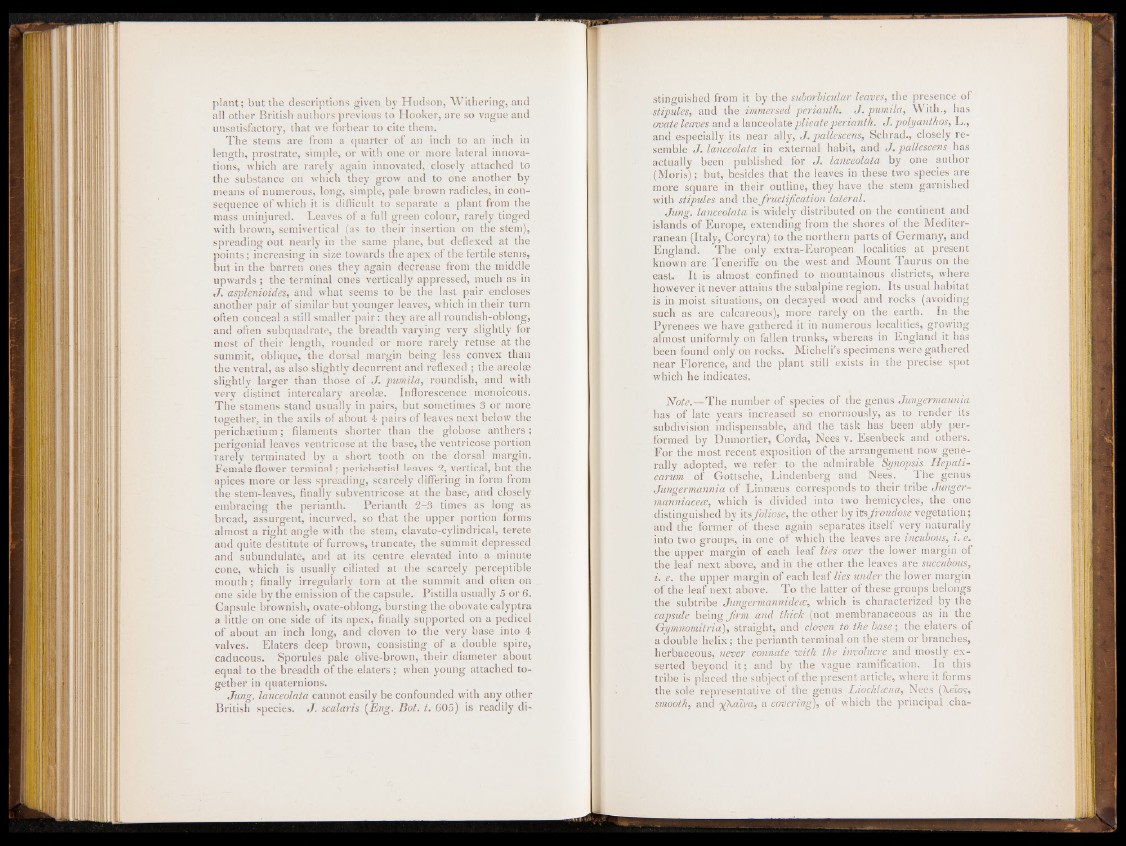
plant; but the descriptions given by Hudson, Withering, and
all other British authors previous to Hooker, are so vague and
unsatisfactory, that we forbear to cite them.
The stems are from a quarter of an inch to an inch in
length, prostrate, simple, or with one or more lateral innovations,
which are rarely again innovated, closely attached to
the substance on which they grow and to one another by
means of numerous, long, simple, pale brown radicles, in consequence
of which it is difficult to separate a plant from the
mass uninjured. Leaves of a full green colour, rarely tinged
with brown, semivertical (as to their insertion on the stem),
spreading out nearly in the same plane, but deflexed at the
points; increasing in size towards the apex of the fertile stems,
but in the barren ones they again decrease from the middle
upwards; the terminal ones vertically appressed, much as in
<7. asplenioides, and what seems to be the last pair encloses
another pair of similar but younger leaves, which in their turn
often conceal a still smaller pair: they are all roundish-oblong,
and often subquadrate, the breadth varying very slightly for
most of their length, rounded or more rarely retuse at the
summit, oblique, the dorsal margin being less convex than
the ventral, as also slightly decurrent and reflexed ; the areolae
slightly larger than those of <7. pumila, roundish, and with
very distinct intercalary areolae. Inflorescence monoicous.
The stamens stand usually in pairs, but sometimes 3 or more
together, in the axils of about 4 pairs of leaves next below the
perichaetium; filaments shorter than the globose anthers;
perigonial leaves ventricose at the base, the ventricose portion
rarely terminated by a short tooth on the dorsal margin.
Female flower terminal; perichaetial leaves 2, vertical, but. the
apices more or less spreading, scarcely differing in form from
the stem-leaves, finally subventricose at the baseband closely
embracing the perianth. Perianth 2-3 times as long as
broad, assurgent, incurved, so that the upper portion forms
almost a right angle with the stem, clavato-cylindrical, terete
and quite destitute of furrows, truncate, the summit depressed
and subundulate, and at its centre elevated into a minute
cone, which is usually ciliated at the scarcely perceptible
mouth ; finally irregularly torn at the summit and often on
one side by the emission of the capsule. Pistilla usually 5 or 6.
Capsule brownish, ovate-oblong, bursting the obovate calyptra
a little on one side of its apex, finally supported on a pedicel
of about an inch long, and cloven to the very base into 4
valves. Elaters deep brown, consisting of a double spire,
caducous. Sporules pale olive-brown, their diameter about
equal to the breadth of the elaters; when young attached together
Jung,i nl aqnucaetoelrantiao cnas.nnot easily be confounded with any other
British species. J. scalaris {Eng. Bot. t. 605) is readily distinguished
from it by the suborbicular leaves, the presence of
stipules, and the immersed perianth. J. pumila, With., has
ovate leaves and a lanceolate plicate perianth. J. polyanthos, L.,
and especially its near ally, J. pallescens, Schrad., closely resemble
<7. lanceolata in external habit, and J. pallescens has
actually been published for J. lanceolata by one author
(Moris); but, besides that the leaves in these two species are
more square in their outline, they have the stem garnished
witJhu nsgti,p ulalensc eaonlda tath ies f rwuicdteifliyc adtiisotnri bluatteerda lo.n the continent and
islands of Europe, extending from the shores of the Mediterranean
(Italy, Corcyra) to the northern parts of Germany, and
England. The only extra-European localities at present
known are Teneriffe on the west and Mount Taurus on the
east. It is almost confined to mountainous districts, where
however it never attains the subalpine region. Its usual habitat
is in moist situations, on decayed wood and rocks (avoiding
such as are calcareous), more rarely on the earth. In the
Pyrenees we have gathered it in numerous localities, growing
almost uniformly on fallen trunks, whereas in England it has
been found only on rocks. Micheli’s specimens were gathered
near Florence, and the plant still exists in the precise spot
which he indicates.
Note.—'The number of species of the genus Jungermannia
has of late years increased so enormously, as to render its
subdivision indispensable, and the task has been ably performed
by Dumortier, Corda, Nees v. Esenbeck and others.
For the most recent exposition of the arrangement now generally
adopted, we refer to the admirable Synopsis Hepati-
carum of Gottsche, Lindenberg and Nees. The genus
Jungermannia of Linnaeus corresponds to their tribe Junger-
manniacece, which is divided into two hemicycles, the one
distinguished by itsfoliose, the other by itsfrondose vegetation;
and the former of these again separates itself very naturally
into two groups, in one of which the leaves are incubous, i. e.
the upper margin of each leaf lies over the lower margin of
the leaf next above, and in the other the leaves are succubous,
i. e. the upper margin of each leaf lies under the lower margin
of the leaf next above. To the latter of these groups belongs
the subtribe Jungermannidece, which is characterized by the
capsule being firm and thick (not membranaceous as in the
Gymnomitria), straight, and cloven to the base; the elaters of
a double helix; the perianth terminal on the stem or branches,
herbaceous, never connate with the involucre and mostly ex-
serted beyond it; and by the vague ramification. In this
tribe is placed the subject of the present article, where it forms
the sole representative of the genus Liochlcena, Nees (Xeto?,
smooth, and yfiaiva, a covering), of which the principal cha